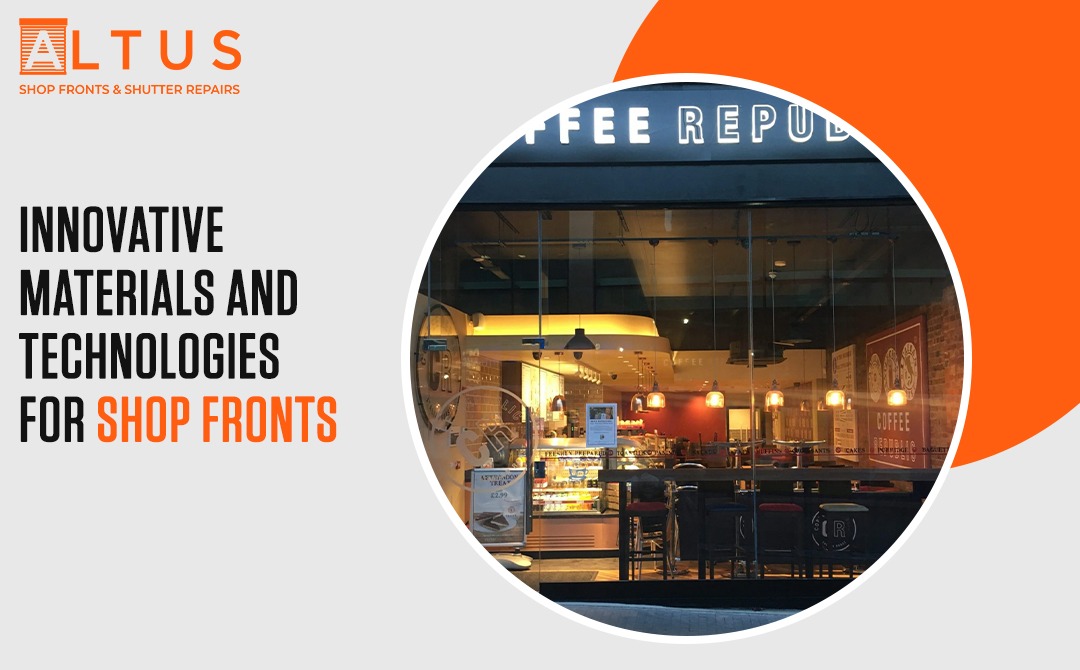Are you looking to make your shopfront stand out and attract more customers? Do you want to enhance the appearance of your store while ensuring its safety and security? Look no further, as innovative materials and technologies for shopfronts can offer you the perfect solution.
Shopfronts are the face of any store and play a vital role in creating a positive first impression on customers. However, traditional shopfronts can be prone to damage, wear and tear, and burglary attempts, which can lead to costly repairs and compromise the safety of your business. That’s where innovative materials and technologies come into play.
At Altus, we understand the importance of a visually appealing and secure shopfront by using modern materials like aluminum, glass, and composite and incorporating technologies like automatic doors, security shutters, and biometric locks. These solutions not only enhance the aesthetics of your store but also improve its energy efficiency and reduce maintenance costs.
The Role of Innovative Materials and Technologies in Shopfront Design
Here are some benefits of using innovative materials and technologies in shopfront design:
- Enhance aesthetics: Innovative materials and technologies can help you create a unique and eye-catching storefront that sets you apart from competitors.
- Improved durability: Advanced materials like composite wood, engineered stones, and aluminum frames are more durable and have a longer lifespan than traditional materials like wood or iron.
- Greater security: Advanced locking mechanisms, security screens, and bulletproof glass can provide extra protection and deter theft, break-ins, and vandalism.
Here are some of the latest materials and technologies being used in the shopfront design industry:
- Nanotechnology: Nano coating can enhance the durability and longevity of surfaces, making them resistant to scratches, dirt, and UV rays.
- Digital signage: LED and LCDs can be integrated into shopfronts, allowing businesses to showcase their products and promotions.
- Smart glass: Glass panels can be made with built-in electronics that allow them to switch from transparent to opaque or change color based on external factors such as light, temperature, or humidity.
The Importance of Sustainable Shopfront Design
Ways in which these materials and technologies can play a role in sustainable shopfront design:
- Reduced energy consumption: Innovative materials such as insulated glass can help reduce energy consumption by minimizing heat transfer between the interior and exterior of the building.
- Improved air quality: Materials like low-emissivity glass can help reduce the amount of ultraviolet and infrared light that enters the building, thereby reducing the formation of harmful pollutants.
- Recyclability: Many innovative materials are recyclable and can be repurposed at the end of their life, reducing the amount of waste that goes to landfills.
- Natural lighting: Technologies such as electrochromic glass allow you to control the amount of natural light entering the building, reducing the need for artificial lighting and conserving energy.
Most sustainable materials and technologies available for shopfront design:
- Low-emissivity glass: This type of glass has a thin, metallic coating that reflects heat while allowing visible light to pass through.
- Insulated glass: This type of glass has a double or triple layer of glass with a sealed air space between the layers, providing excellent insulation.
- Electrochromic glass: This type of glass can change its tint to control the light and heat entering the building.
- Natural materials: Materials such as bamboo, cork, and reclaimed wood can provide a sustainable and eco-friendly option for shopfront design.
How to Implement Innovative Materials and Technologies in Shopfront Design
- Research and select the suitable materials and technologies for your specific needs and budget.
- Consult with professionals such as architects and engineers to ensure proper installation and use of materials and technologies.
- Train staff on the proper maintenance and care of materials and technologies to ensure longevity and optimal performance.
- Consider sustainable materials and technologies’ potential cost savings and long-term benefits.
- Factor in the cost of installation, maintenance, and potential repairs when calculating the cost of using these materials and technologies.
Conclusion
Innovative materials and technologies can significantly improve your shopfront’s aesthetics, security, and functionality, making it more attractive to potential customers. By incorporating sustainable materials and technologies into your shopfront design, you can reduce your environmental impact and appeal to consumers who value sustainability.
While the initial cost of using innovative materials and technologies may be higher than traditional materials, the long-term benefits in energy efficiency, durability, and maintenance costs can more than offset these costs.
To implement innovative materials and technologies in your shopfront design, you must work closely with experienced architects and designers who can provide you with practical advice on the best materials and technologies to use. They can also help you balance your desire for innovation with your budgetary constraints.




